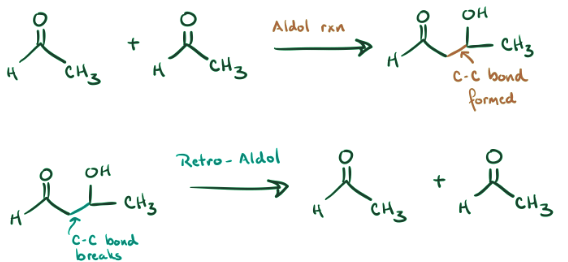Aldol Reactions in Metabolism: Unveiling the Chemistry and Mechanisms | Organic Chemistry for MCAT PDF Download
| Table of contents |

|
| Introduction |

|
| Understanding Aldol Reactions: Chemistry and Mechanism |

|
| Aldol Reactions in Metabolism |

|
| Retro-Aldol Reactions: Breaking Carbon-Carbon Bonds |

|
Introduction
Aldol and retro-aldol reactions, although commonly associated with organic chemistry, play a crucial role in biochemical pathways. In this article, we will explore the fascinating world of aldol reactions in metabolism, uncovering their mechanisms and significance in key biochemical reactions. From the first step of the Kreb's cycle to the gluconeogenesis pathway, we will delve into the chemistry behind these reactions and their impact on the formation of vital compounds. Additionally, we will shed light on retro-aldol reactions, the reverse processes of aldol reactions, and their relevance in metabolic pathways.

Understanding Aldol Reactions: Chemistry and Mechanism
Before exploring aldol reactions in metabolism, it is essential to grasp their fundamental principles. Aldol reactions involve aldehydes and ketones and occur in three primary steps: electrophilic attack, nucleophilic attack, and protonation. Additionally, under specific conditions, a fourth step known as dehydration can occur, leading to the formation of αβ-unsaturated aldehydes or ketones. We will delve into the distinction between aldol addition and aldol condensation reactions based on the presence of the dehydration step.
Aldol Reaction Mechanism
In this section, we will illustrate the mechanism of an aldol reaction using acetaldehyde as an example. Starting with the formation of an enolate intermediate, we will walk through the subsequent steps, resulting in the generation of an aldol product. The article provides clear diagrams to aid in understanding each step of the mechanism and highlights the formation of a new carbon-carbon bond and the significance of elevated temperatures in the process.
Aldol Reactions in Metabolism
Enzymes act as catalysts in biochemical reactions, including aldol reactions. In this section, we will focus on the involvement of aldolase enzymes, specifically in two crucial metabolic processes: the first step of the Kreb's cycle and the gluconeogenesis pathway. Through detailed explanations and reaction mechanisms, we will shed light on how aldol reactions contribute to the synthesis of essential compounds.

Aldol Reactions in the Kreb's Cycle
The first step of the Kreb's cycle, also known as the citric acid cycle or tricarboxylic acid (TCA) cycle, employs aldol reactions to combine acetyl CoA with oxaloacetate. The article provides a step-by-step breakdown of the reaction mechanism, emphasizing the formation of a new carbon-carbon bond and a stereo-center. Furthermore, it explores how enzymes play a crucial role in creating specific stereocenters within the active site.
Aldol Reactions in Gluconeogenesis
In the gluconeogenesis pathway, aldol reactions facilitate the formation of fructose 1,6-bisphosphate by condensing glyceraldehyde-3-phosphate (GAP) and dihydroxyacetone phosphate (DHAP). Through an in-depth exploration of the reaction mechanism, the article elucidates the role of fructose 1,6-bisphosphate aldolase, a Class II aldolase enzyme with a bound metal cation. It highlights the stereo-specificity of the reaction and the creation of a new stereocenter.
Retro-Aldol Reactions: Breaking Carbon-Carbon Bonds
Transitioning to retro-aldol reactions, we embark on a reverse journey where carbon-carbon bonds are broken to form two fragments. While aldol reactions are generally reversible, the article explains how aldolase enzymes can catalyze retro-aldol reactions, particularly in the glycolysis pathway. By exploring the cleavage of fructose 1,6-bisphosphate into DHAP and GAP, the article provides a comprehensive mechanism, illustrating the role of base abstraction and protonation.

Conclusion
Aldol reactions, both in their conventional form and as retro-aldol reactions, are integral to metabolic pathways. Understanding the chemistry and mechanisms behind these reactions enables us to appreciate the complexity and elegance of biochemical processes. By examining their involvement in the Kreb's cycle and gluconeogenesis, we gain insight into the intricate interplay of enzymes and chemical reactions that fuel our biological systems. The article concludes by emphasizing the significance of aldol reactions in metabolism and their contribution to the formation of crucial compounds necessary for life.
|
140 videos|5 docs|15 tests
|

|
Explore Courses for MCAT exam
|

|
















